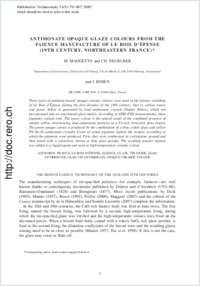Antimonate opaque glaze colours from the faience manufacture of Le Bois d'Épense (19th century, Northeastern France)*
- Maggetti, Marino Department of Geosciences, University of Fribourg, Switzerland
- Neururer, Christoph DR CNRS, Dijon, France
- Rosen, J. DR CNRS, Dijon, France
-
02.12.2008
Published in:
- Archaeometry. - 2009, vol. 51, no. 5, p. 791-807
English
Three types of antimony-based, opaque ceramic colours were used in the faience workshop of Le Bois d'Épense during the first decades of the 19th century; that is, yellow, tawny and green. Yellow is generated by lead antimonate crystals (Naples Yellow), which are incorporated into an uncoloured glass matrix. According to SEM–EDS measurements, these pigments contain iron. The tawny colour is the optical result of the combined presence of similar yellow, iron-bearing lead antimonate particles in a Fe-rich, brownish glass matrix. The green opaque colour is produced by the combination of a blue cobalt glass and yellow Pb–Sn–Fe-antimonate crystals. Cores of zoned pigments lighten the recipes, according to which the pigments were produced. First, they were synthesized by calcination, ground and then mixed with a colourless, brown or blue glass powder. The resulting powder mixture was added to a liquid agent and used as high-temperature ceramic colour.
- Faculty
- Faculté des sciences et de médecine
- Department
- Département de Géosciences
- Language
-
- English
- Classification
- Engineering materials
- License
-
License undefined
- Identifiers
-
- RERO DOC 13180
- DOI 10.1111/j.1475-4754.2008.00442.x
- Persistent URL
- https://folia.unifr.ch/unifr/documents/301319
Statistics
Document views: 137
File downloads:
- pdf: 348
